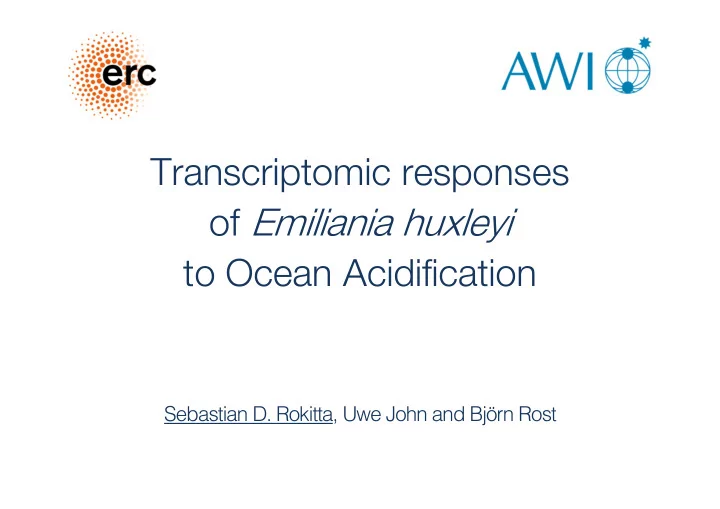

Transcriptomic responses of Emiliania huxleyi to Ocean Acidification Sebastian D. Rokitta, Uwe John and Björn Rost
Ocean Acidifcation 2- 2- ] [CO [CO 2 ] pH pH SWS [CO [CO 3 [DIC] [DIC] SWS [ μ mol kg mol kg -1 -1 ] [ μ mol kg mol kg -1 -1 ] pH pH 8. 8.2 300 300 2400 240 35 35 DIC DIC 30 30 250 250 200 2000 8. 8.1 25 25 200 200 1600 160 2- 2- CO CO 3 20 20 150 150 120 1200 8.0 8. 15 15 100 100 800 800 10 10 7. 7.9 CO 2 CO 50 50 400 400 5 0 0 7.8 7. 0 185 1850 190 1900 195 1950 2000 200 205 2050 210 2100 Year Year After Wolf-Gladrow et al. (1999)
Coccolithophores Photo: NASA, PML Photo: NASA, PML
Biological carbon pumps
OA-responses in E. huxleyi Modified from Hoppe et al. (2011)
Energization?
The matrix approach Light vs. pCO Light vs. pCO 2 380 μ atm 380 1000 1000 μ atm atm atm 50 μ mol 50 -2 s -1 mol photon hotons m -2 -1 300 300 μ mol -2 s -1 mol photon hotons m -2 -1 • Acclimation data ( μ , POC, PIC) • Physiology (C i acquisition, light reactions) • Transcriptomics (gene expression)
Phenomenology Rokitta & Rost (2012) • PIC production drops (especially under low light!) • POC production is boosted (especially under low light!) • TPC production is insensitive
Physiology Rokitta & Rost (2012) • More POC despite less pigmentation and O 2 evolution Improved energy efficiency under OA
Gene expression?
Transcriptomics OA responsive genes 1172 ↑ Low-light acclimation 861 ↓ High-light 1082 ↑ acclimation 814 ↓
Transcriptomics 447 ↑ Low-light specific 236 ↓ 725 ↑ Core 625 ↓ OA-response 357 ↑ High-light specific 189 ↓
Transcriptomics Core Core LL specific LL specif HL sp HL specific ific OA-res OA-respo ponse OA-res OA-respo ponse OA-respo OA-res ponse Carbon metabolism Carbon metabolism Light physiology Light physiology Signalling Signalling Ion fluxes Ion fluxes -40 -40 -20 20 0 20 40 -40 40 -20 -20 0 20 20 40 40 -40 -40 -20 20 0 20 40 # of genes; sign denotes regulation (+ (+ ↑ ; - ; - ↓ ) Pentose Pentose phosphate hosphate pathway pathway ↑ Regulation of C Regulation of C fluxes fluxes ↑ Organellar shuttling ↑ Organellar shuttling Glyco Glycolysis ↓ Fatty Acid Fatt cid & Glucan anabo Glucan anabolism ↑ Energ Energy dissipation dissipation ↑ Energ Energy dissipation dissipation ↑ Lipid and Lipid and IP 3 signaling signaling ↑ Membrane potentials Membrane potentials ↑
OA re-wires carbon fluxes NADPH NADH
OA affects the redox hub NADP/NADPH NADP/NADPH NAD/NADH NAD/NADH GSH Mitochon- tochon- driu drium Asc Carbon Carbon Chloro- Chloro- Trx metabolism metabolism plast plast XC ... EMS EMS
Conclusions • OA causes a shunting of carbon from calcification towards biomass production • OA-Responses are modulated by energy availability and typically attenuated by high light • OA affects cellular signaling and the redox hub and thereby re-wires carbon flux networks
Recommend
More recommend